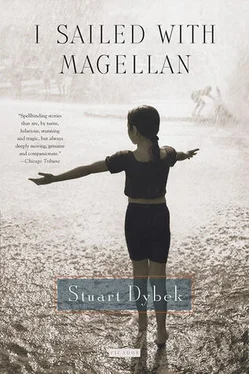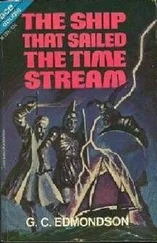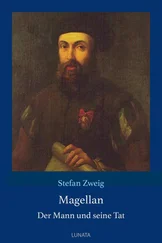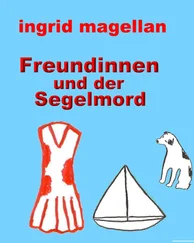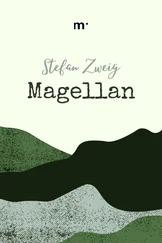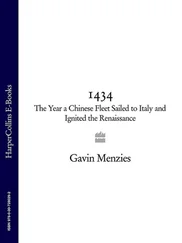At my father’s funeral, when there might have been an opportunity to pay a few words of respect, that story set in the dead of winter returned to my mind. It was summer in Memphis—“a scorcher,” my father would have called it — and his story seemed even more foreign there. Not the actual feeling itself, but the recollection of an old feeling from childhood, one for which I still don’t have a name, returned: an inexpressible protectiveness toward my father, a concern that, despite his faith in hard work and practicality, he’d never wholly appraised the reality of the country we lived in. We shared a home, we shared a life, but there was a dimension separating us. He inhabited another America, a distant place like Dickens’s London or Goigol’s Moscow. He feared that we, his sons, would go wanting, and that fear had set him at odds with us. I thought of telling his Teddy Kanik story at the wake but wasn’t sure what the point might be; the story wasn’t a way he’d want to be remembered in public, or a way of saying goodbye. And yet the story itself diminished anything else I could think of to say, and so, to my shame, I left my father unprotected and sat silently and listened to the priest mouth the usual clichés.
Mick had flown in from New York for the funeral toting a huge, bulging soft-sided plaid suitcase. Before his flight, he’d rushed to the Lower East Side to buy containers of pierogi and borscht, jars of herring, garlic dills, horseradish, kraut, links of fresh and smoked kielbasa — sausages my father loved and wasn’t able to eat in his last years because of his restricted diet. Mick knew that after the funeral a meal would be required. He stuffed in a bottle of wisniowka —a cherry brandy — and a bottle of 150 proof Demerara rum, then, at LaGuardia, checked the suitcase through to Memphis. Everything but the wisniowka and rum arrived broken and run together.
The rum was for Mick’s private tribute. He’d worked as a bouncer at a strip club on Forty-second Street and lived with one of the dancers, a striking Puerto Rican woman who’d introduced Mick to Santeria. He’d become an initiate and wanted to become a santero. He wore his caracoles —a shell necklace no one was allowed to touch — and brought a thick black candle inscribed with esoteric symbols that he erected before our father’s tomato patch as if we had buried him in the back yard. It was an offering made to Oya, patron of whirlwinds and cemeteries, to ease the entrance to the world of the dead. Oya’s syncretic form, he explained, to ease our mother’s misgivings, was Our Lady of Montserrat. Beside the candle, he set a shot of rum; Oya, fiercest of the female orishas, liked her drink strong. In the humid, bug-roaring darkness of Memphis, the orange candle flame flickered eerily off the tomato netting until Moms went out and drenched it with a blast from the garden hose.
The rum that Oya didn’t require Mick and I killed driving around at night between barbecue places and country bars in my father’s gold Chrysler. We ended up in a pool hall. My father had been a skilled pool player. Neither Mick nor I had inherited the gene. Maybe it was the similarity of our inept play, but people kept asking if we were twins. No, we told them, just brothers.
After the funeral we served a meal of Memphis barbecue and Lower East Side Polish sausage to my father’s surviving brother and three of his sisters, who’d all traveled from Chicago. We said a brief prayer and downed a wisniowka in a silent toast to my father’s memory.
I sat beside my aunt Olga, my father’s youngest sister.
“When we were kids, your father kept us all going,” she told me. “One year, when we barely had enough to eat, he somehow managed to show up with a tree on Christmas Eve, because, he said, our family shouldn’t be without one. He was a good brother. He was a good guy.”
“He never told me about that,” I said.
She dabbed her eyes. “There’s a lot he didn’t talk about.”
That was the first of times to come when missing my father took the shape of being startled that he was no longer there to answer a question regarding a past I knew so little about, to which he’d been my only link. I wished, with an intensity that ambushed me, that I could have asked him for the details on how he’d come up with the tree. It sounded like another story that might have made Charles Dickens proud.
When, in her composition, Camille Estrada told how she’d seen Charles Dickens standing on Washtenaw, I too saw him, a familiar face among the crowd watching Tito Guízar ride by. Camille might have argued that if Tito Guizar could actually appear parading through Little Village behind the miraculous Virgin, then why not Charles Dickens? The appearance of the Mexican cowboy star, complete with stallion, sombrero, a guitar strapped across his back, was barely less remarkable than that of an old British writer would have been. Dickens was the man in a starched collar with a blue cravat that matched his worn, serious eyes; his auburn hair was thinning, his flowing beard was the kind one saw on hoboes who lived by the railroad tracks. That was how Dickens was pictured on the card in Authors, a game our family played. Dickens shared the deck with Shakespeare, Sir Walter Scott, James Fenimore Cooper, Washington Irving, Longfellow, Tennyson, Louisa May Alcott, Twain, Poe, Hawthorne. At bedtime, our mother would read from those authors to Mick and me.
“No wild stuff,” she’d caution, “this is reading time.”
It was the closest thing Mick and I had to sacred time.
On the Dickens card, beneath his likeness, four books were listed: Pickwick Papers, David Copperfield, Oliver Twist, A Christmas Carol . Of those, Moms read Oliver Twist . We owned a set of 78 rpm records of a dramatized reading of A Christmas Carol starring Basil Rathbone, who was also Sherlock Holmes. My father had gotten a good deal on it at Maxwell Street.
Camille had tried to summon up the authority of Dickens’s fiction to justify the true story of Ralphie she wanted to tell, a story destined to end with the hopelessly pathetic fact of a boy dying on Christmas Eve. On some level she must have asked herself, who would read A Christmas Carol a second time if Tiny Tim died at the end? She needed a rebirth, a resurrection. A year had passed without a single miracle. Although parishioners had prayed for the Blue Boy so long that it had become a habit, they were bound to give up praying to him. It would occur to them, as it had to me the one shameful time I prayed to Ralphie and asked him to help me make the basketball team, that if Ralphie’s wish to make his First Holy Communion hadn’t been granted, why would he have the clout to intercede for anyone else? Gradually, but sooner than had ever seemed possible, he would be forgotten.
Camille needed to summon the timeless power of Dickens’s story in order to superimpose what remained of Ralphie’s spirit on the streets of Little Village. Her borrowing of images from Dickens wasn’t so different from the local spray-can artists who painted murals on the crumbling walls, as if Diego Rivera — like visions might shore up what urban renewal had not. There was a permanence to Dickens’s story that Camille aspired to. And in that, her tribute was not unlike the tributes of the gang bangers who sometimes tattooed an indelible blue tear at the outside corner of one eye in memory of a wasted homey. That was what Tony Bizzaro did after his brother, Peanuts, died.
It’s about feeling, Camille had told me that one afternoon when we were Partners in Christ.
She refused to settle for a tribute that took the shape of silence. She failed for want of accuracy, but not of feeling. Not for want of amor .
Читать дальше
